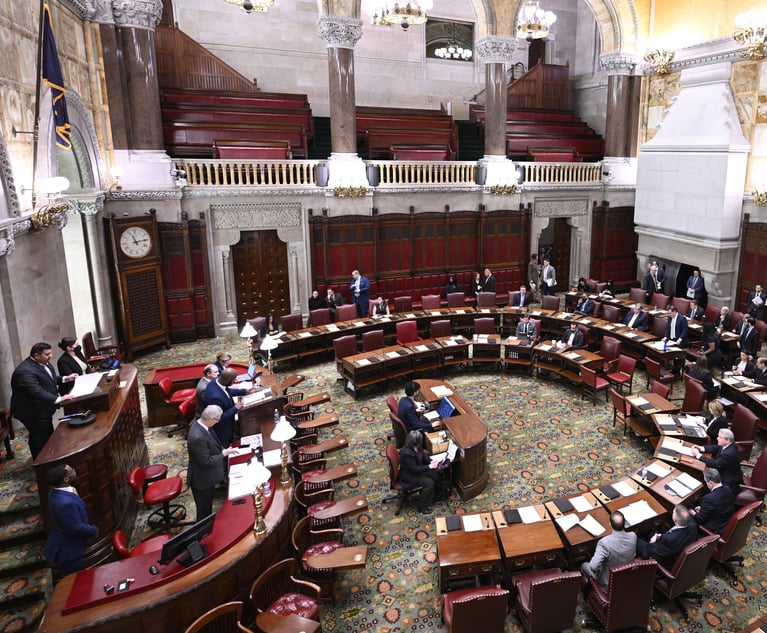Insurance Coverage in the Wake of the New York Child Victims Act and Sex Abuse Lawsuits
While coverage ultimately turns on the specific facts and allegations, the policy language, and applicable state law, policyholders should be aware of key considerations and best practices to maximize coverage in sexual abuse cases.
August 23, 2019 at 11:45 AM
9 minute read
 New York recently enacted the Child Victims Act, extending the limitations period to age 55 for victims to bring claims of childhood sexual abuse against their abusers, as well as institutions.
New York recently enacted the Child Victims Act, extending the limitations period to age 55 for victims to bring claims of childhood sexual abuse against their abusers, as well as institutions.
Child sex abuse survivors—regardless of age—have one year from Aug. 14, 2019 to bring civil claims in New York. Hundreds of lawsuits have already been filed against major institutions such as the Catholic Church and the Boy Scouts of America. The lawsuits allege that the institutions negligently hired, retained, and/or supervised alleged abusers.
Insurance coverage disputes are sure to follow this wave of sex abuse lawsuits, as demonstrated by the fact that several institutions have already filed lawsuits against insurers seeking coverage and payment of defense costs in sexual abuse lawsuits.
While coverage ultimately turns on the specific facts and allegations, the policy language, and applicable state law, policyholders should be aware of key considerations and best practices to maximize coverage in sexual abuse cases.
How To Maximize Coverage in Sex Abuse Cases
Locate All Policies Held During the Period of Alleged Abuse. The first step in any insurance coverage case is to locate the policies that may provide coverage for the claims at issue. Alleged sexual abuse may date back to the 1960s or earlier. Insurance coverage is triggered by bodily injury as a result of an "occurrence" during the policy period.
The scope of coverage was narrowed in the 1980s with sexual abuse exclusions. It is important in cases alleging sexual abuse dating back to the 1960s and 1970s to perform an extensive search of records and archives for all policies held by the institution during the period of the alleged abuse.
Provide Notice of Claims as Soon as Practicable. Providing written notice of claims in accordance with the applicable policy is a critical step to obtaining an insurance recovery. Disputes about whether a notice of claims is timely are likely to arise in situations where the institution is alleged to have had knowledge of sexual abuse prior to the filing of the lawsuit.
An institution may not know about alleged sexual abuse until the lawsuit is filed. Where the underlying sexual abuse lawsuit is the institution's first notice of alleged abuse and a potential claim for coverage, the timeliness of its notice of claims is less likely to be a point of contention.
Engage a Lost Policy Expert and Retain Counsel With Experience Proving Up 'Old' Policies. Engage a lost policy expert to work with counsel to locate all insurance policies from the period of alleged sexual abuse. There are a number of very good lost policy experts who can expedite the process of locating historic insurance policies.
The standards are low in pricing up coverage in court, if necessary. Make sure to retain counsel with a record of litigating and proving up old insurance policies.
Trigger as Many Policies as Possible. Since often the limits were much lower in the earlier policies, the key to maximizing coverage will be to trigger as many policies as possible for the same alleged abuse.
The Bankruptcy Court for the District Court for Minnesota in In re Diocese of Duluth, 565 B.R. 914 (Bankr. D. Minn. 2017) was faced with determining trigger and the number of "occurrences" related to negligence claims asserted against the Diocese by victims of priest sexual abuse. The policies provided coverage for damages for personal injury caused by an occurrence.
Most of the insurers argued for the interpretation that there was only one occurrence—the ongoing act of negligent supervision by the Diocese resulting in the continuous and repeated exposure of the victims to the abusive priests regardless of the number of victims or abusers involved. The Diocese, on the other hand, argued that each alleged act of abuse constituted a separate occurrence under all the policies.
The court ruled in favor of the Diocese, finding that multiple years of coverage could be triggered and that multiple occurrences could be found in each policy year as each victim was a separate occurrence. The court applied the Minnesota actual injury or injury-in-fact trigger rule, which provides that an occurrence take place at the time the complaining party as actually injured, not when the wrongful act was committed. Because abuse was what caused the victims' damage, the occurrence was the time when the victims were sexually abused, and the number of occurrences to trigger the insurance policies could be both per victim and per priest.
A Pennsylvania court also addressed this issue in connection with the Sandusky scandal at Penn State University, but came to the opposite conclusion. Pennsylvania State Univ. v. Pennsylvania Mfrs. Ass'n Ins. Co., 2016 WL 2737479 (Pa. Com. Pl. May 4, 2016). The court did not allow Penn State to trigger multiple policy periods for subsequent acts of abuse against the same victim. According to the court, there was an occurrence when the first abuse and bodily injury was experienced by each victim. The court noted that its decision followed prior Pennsylvania Superior Court authority which held that each victim constitutes only one occurrence, no matter how many separate instances of sexual abuse take place.
It is worth noting that the court in the Penn State case was only dealing with occurrences of sexual abuse by one abuser. The court may have reached a different conclusion as to the number of occurrences in a situation with multiple abusers.
Triggering multiple policies with numerous occurrences over a period of years greatly broadens the coverage obligation and increases the potential insurance recovery significantly. The number of "occurrences" and triggers in sexual abuse cases is an open issue in most jurisdictions. At the least, the trigger and number of occurrence rules in a particular jurisdiction should be taken into account in deciding where to file a sex abuse coverage lawsuit given the potential impact of such rules on recovery.
Make a Strategic Decision About Where to File. In the event it becomes necessary to file a lawsuit for coverage, make a strategic decision about where to file. Where a coverage lawsuit is filed can be case dispositive or significantly affect the applicable limits. Insurers may try to file first to obtain a better jurisdiction. Be the first to file when it becomes clear that the insurer is denying coverage.
Alleged Negligent Hiring and Supervision Is a Covered "Occurrence" Under New York Law. The typical Commercial General Liability (CGL) policy requires that the insurer indemnify the policyholder for damages arising from personal injury resulting from an occurrence during the policy period. A critical issue in determining coverage for sexual abuse claims is whether the alleged sexual abuse is an "occurrence" as defined in the policy.
A common form of CGL policy defines an "occurrence" as an accident resulting in bodily injury which is neither expected nor intended by the policyholder. This standard definition does not include injury resulting from intentional acts like sexual abuse. However, New York courts have extended coverage to claims of negligent hiring and supervision of alleged abusers by policyholder institutions.
Anticipate Arguments by Insurers About Per-Occurrence Limitations on Liability. Expect that insurers will attempt to limit or deny coverage on the ground that a per-occurrence retention limitation applies to each separate incident of sexual abuse and bars coverage. Liability insurance policies written on a per-occurrence basis generally provide coverage for losses that occur during the policy period, arising out of an "occurrence." In general (and subject to policy definitions), an occurrence means not only a discrete accident or event, but also continuous exposure to the same harmful conditions.
Per-occurrence limitations of liability are particularly important in sexual abuse cases. An insurer's indemnity obligation is generally limited to a specified amount per occurrence. A critical issue is whether underlying sexual abuse claims constitute a single occurrence that exhausts a policy's per-occurrence limit of liability.
The New York Supreme Court in American Home Assurance Company v. Port Authority of New York & New Jersey, No. 651096/2012, 2017 WL 5890776 (N.Y. Sup. Ct. Nov. 29, 2017) rejected an insurer's argument that underlying asbestos claims arising out of fireproofing activities at the WTC project constituted a single occurrence, and accordingly held that the insurer policy's per-occurrence limit of liability was not exhausted. The American Home case suggests that a New York court may hold similarly in a sexual abuse coverage case and find that sexual abuse claims are not a single occurrence that exhausts a per-occurrence limit of liability.
Even if a policy's limits of liability are determined to be exhausted, it is important to remember that the insurer's duty to defend its policyholder from the underlying claims may nevertheless continue.
Sexual Abuse Lawsuits and Related Coverage Disputes Are Not Going Away. Sexual abuse lawsuits are not restricted to specific institutions; religious organizations, schools, hospitals, and youth programs are likely targets. There is growing public pressure on state legislatures to lift or suspend the statute of limitations for bringing sexual abuse claims.
This year alone, 17 states have revised the limitations period for sexual abuse claims, including the state of New Jersey, which is set to open a two-year revival window on Dec. 1, 2019 for victims sexually abused as minors or adults.
As more and more states follow New York's lead and extend limitation periods for child sex abuse claims, the number of lawsuits will continue to increase exponentially. Insurance companies are already preparing for the impending payout. Two major U.S. insurers—Travelers Co. and Chubb Ltd.—stated during recent earnings calls that they have added to their reserves due to uncertainty about sexual-abuse liabilities.
Insurers are likely to delay payments for coverage of sexual abuse claims under a wait-and-see approach until they have a better understanding of the impact that laws like the New York Child Victims Act will have on their bottom line. Policyholders should expect that insurers will resist funding settlements of sexual abuse lawsuits given the lack of cases decided under newly enacted laws. But no amount of delay or resistance on the insurers' part will make sexual abuse lawsuits and corresponding coverage obligations go away.
Robin Cohen is the head of the McKool Smith's insurance recovery practice, based in New York. Lauren Varnado is a principal in the firm's Houston office. They can be reached at [email protected] and [email protected], respectively.
This content has been archived. It is available through our partners, LexisNexis® and Bloomberg Law.
To view this content, please continue to their sites.
Not a Lexis Subscriber?
Subscribe Now
Not a Bloomberg Law Subscriber?
Subscribe Now
NOT FOR REPRINT
© 2025 ALM Global, LLC, All Rights Reserved. Request academic re-use from www.copyright.com. All other uses, submit a request to [email protected]. For more information visit Asset & Logo Licensing.
You Might Like
View All

Federal Judge Pauses Trump Funding Freeze as Democratic AGs Plan Suit
4 minute read
Relaxing Penalties on Discovery Noncompliance Allows Criminal Cases to Get Decided on Merit
5 minute read
Bipartisan Lawmakers to Hochul Urge Greater Student Loan Forgiveness for Public-Interest Lawyers
Trending Stories
- 1Uber Files RICO Suit Against Plaintiff-Side Firms Alleging Fraudulent Injury Claims
- 2The Law Firm Disrupted: Scrutinizing the Elephant More Than the Mouse
- 3Inherent Diminished Value Damages Unavailable to 3rd-Party Claimants, Court Says
- 4Pa. Defense Firm Sued by Client Over Ex-Eagles Player's $43.5M Med Mal Win
- 5Losses Mount at Morris Manning, but Departing Ex-Chair Stays Bullish About His Old Firm's Future
Who Got The Work
J. Brugh Lower of Gibbons has entered an appearance for industrial equipment supplier Devco Corporation in a pending trademark infringement lawsuit. The suit, accusing the defendant of selling knock-off Graco products, was filed Dec. 18 in New Jersey District Court by Rivkin Radler on behalf of Graco Inc. and Graco Minnesota. The case, assigned to U.S. District Judge Zahid N. Quraishi, is 3:24-cv-11294, Graco Inc. et al v. Devco Corporation.
Who Got The Work
Rebecca Maller-Stein and Kent A. Yalowitz of Arnold & Porter Kaye Scholer have entered their appearances for Hanaco Venture Capital and its executives, Lior Prosor and David Frankel, in a pending securities lawsuit. The action, filed on Dec. 24 in New York Southern District Court by Zell, Aron & Co. on behalf of Goldeneye Advisors, accuses the defendants of negligently and fraudulently managing the plaintiff's $1 million investment. The case, assigned to U.S. District Judge Vernon S. Broderick, is 1:24-cv-09918, Goldeneye Advisors, LLC v. Hanaco Venture Capital, Ltd. et al.
Who Got The Work
Attorneys from A&O Shearman has stepped in as defense counsel for Toronto-Dominion Bank and other defendants in a pending securities class action. The suit, filed Dec. 11 in New York Southern District Court by Bleichmar Fonti & Auld, accuses the defendants of concealing the bank's 'pervasive' deficiencies in regards to its compliance with the Bank Secrecy Act and the quality of its anti-money laundering controls. The case, assigned to U.S. District Judge Arun Subramanian, is 1:24-cv-09445, Gonzalez v. The Toronto-Dominion Bank et al.
Who Got The Work
Crown Castle International, a Pennsylvania company providing shared communications infrastructure, has turned to Luke D. Wolf of Gordon Rees Scully Mansukhani to fend off a pending breach-of-contract lawsuit. The court action, filed Nov. 25 in Michigan Eastern District Court by Hooper Hathaway PC on behalf of The Town Residences LLC, accuses Crown Castle of failing to transfer approximately $30,000 in utility payments from T-Mobile in breach of a roof-top lease and assignment agreement. The case, assigned to U.S. District Judge Susan K. Declercq, is 2:24-cv-13131, The Town Residences LLC v. T-Mobile US, Inc. et al.
Who Got The Work
Wilfred P. Coronato and Daniel M. Schwartz of McCarter & English have stepped in as defense counsel to Electrolux Home Products Inc. in a pending product liability lawsuit. The court action, filed Nov. 26 in New York Eastern District Court by Poulos Lopiccolo PC and Nagel Rice LLP on behalf of David Stern, alleges that the defendant's refrigerators’ drawers and shelving repeatedly break and fall apart within months after purchase. The case, assigned to U.S. District Judge Joan M. Azrack, is 2:24-cv-08204, Stern v. Electrolux Home Products, Inc.
Featured Firms
Law Offices of Gary Martin Hays & Associates, P.C.
(470) 294-1674
Law Offices of Mark E. Salomone
(857) 444-6468
Smith & Hassler
(713) 739-1250






